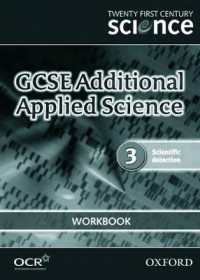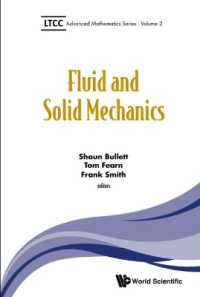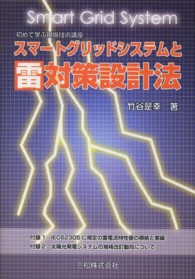Full Description
Respected professor, avid researcher, and prolific author Carole T. Ferrand offers a brand new edition of her widely-read and highly-regarded resource for students and clinicians of the communication sciences and disorders. Speech Science: An Integrated Approach to Theory and Clinical Practice, 3/econtinues to highlight the close relationship between the scientific study of speech production and perception, and the application of this data to the evaluation and treatment of communication disorders. Dr. Ferrand integrates scientific material on the acoustics, anatomy, and physiology of speech production and perception with state-of-the-art instrumental techniques used in clinical practice to create the most comprehensive, detailed approach to the subject. While the focus of the book remains unchanged, the text now features a new re-organization for a greater flow of information, all chapters have been updated with current research, and additional integrative case studies have been included within many of the clinical chapters.
Contents
Foreword Preface to Third Edition Acknowledgments Introduction CHAPTER 1: The Nature of Sound International System of Units Basic Physics Concepts Mass, force, weight, volume, density Speed, velocity, momentum, acceleration, inertia Elasticity, stiffness Work, energy, power, intensity Pressure Overview of Sound Air Air pressure Air flow Air pressure, volume, and density Sound: Changes in Air Pressure Elasticity, inertia, and friction Wave motion of sound Mass/spring system Simple harmonic motion Frequency, period, wavelength, velocity, and amplitude Pure tones Visually depicting sound waves: waveforms Complex Sounds Visually depicting sound waves: spectra Sound Absorption, Reflection, Refraction, and Diffraction Constructive and Destructive Interference Attributes of Sounds Frequency and pitch Human range of hearing Amplitude, intensity, and loudness Decibel scale Advantages of the decibel scale Applications of the decibel scale Summary Review Exercises CHAPTER 2: Resonance Acoustic Resonance Tube resonators and standing waves Acoustic resonators as filters Bandwidth Cutoff frequencies Resonance curves Parameters of a filter Types of filters Vocal Tract Resonance Characteristics of the vocal tract resonator Source-filter theory of vowel production Formant frequencies related to oral and pharyngeal volumes Vowel formant frequencies F1/F2 plots Summary Review Exercises CHAPTER 3: The Articulatory System Articulators of the Vocal Tract Oral cavity Lips Mandible Teeth Dental occlusion Hard palate Soft palate Muscles of the velum Velopharyngeal closure Tongue Muscles of the tongue Tongue movements for speech and swallowing Pharynx Muscles of the pharynx Nasal cavities Valves of the vocal tract Traditional Classification System of Consonants and Vowels Place of articulation of English consonants Manner of articulation of English consonants Stops Fricatives Affricates Nasals Glides Liquids Voicing Vowel classification Acoustic Characteristics of Vowels and Consonants Spectrographic analysis Narrowband and wideband spectrograms Vowels Diphthongs Nasals Glides Liquids Stops Silent gap Release burst Voice onset time Formant transitions Fricatives Affricates The Production of Speech Sounds in Context Coarticulation Suprasegmentals Intonation Stress Duration Summary Review Exercises CHAPTER 4:Clinical Application: Evaluation and Treatment of Disorders Related to Articulation Kinematic Measures of Articulatory Variables Cineradiography Strain gauge X-ray microbeam Ultrasound Electropalatography and glossography Magnetic resonance imaging Electromagnetic articulography Articulation and Intelligibility Dysarthria/Apraxia Acoustic measures Vowel formant analysis Spectral analysis of consonants Kinematic measures Cineradiography Strain gauge Electropalatography Electromagnetic articulography Hearing Impairment Acoustic measures Kinematic measures Electropalatography and glossography Cochlear implantation Acoustic measures Kinematic measures Phonological/Articulatory Disorders Acoustic measures Kinematic measures Ultrasound Electropalatography Cleft Palate Summary Review Exercises Integrative Case Studies CHAPTER 5:The Phonatory system Laryngeal Skeleton Bones and cartilages Joints of the larynx Valves within the Larynx Aryepiglottic folds False vocal folds True vocal folds Cover-body model Glottis Muscles of the Larynx Extrinsic muscles Intrinsic muscles Myoelastic-Aerodynamic Theory of Phonation Mucosal wave Phonation threshold pressure Glottal spectrum Harmonic spacing Nearly periodic nature of the human voice Vocal Quality Normal vocal quality Abnormal vocal qualities Breathy voice Rough/hoarse voice Vocal Registers Physiological and acoustic characteristics of modal, pulse, and falsetto registers Use of different registers in singing and speaking Acoustic Measures of Phonatory Variables Frequency and intensity variables Average fundamental frequency Frequency variability Maximum phonation frequency range Voice amplitude/intensity Average amplitude level Amplitude variability Dynamic range Voice range profile Perturbation measures Noise measures Summary Review Exercises CHAPTER 6: Clinical Application: Evaluation and Treatment of Phonatory Disorders Electroglottography EGG and registers EGG slope quotients Endoscopy and Videostroboscopy High speed Digital Imaging Videokymography Advantages of Acoustic and Visual Analysis of Phonatory Function Laryngeal Aging Acoustic changes over the lifespan Neurological Disorders Amyotrophic lateral sclerosis Parkinson's disease Unilateral vocal fold paresis/paralysis Spasmodic dysphonia Paradoxical vocal fold motion Benign mucosal lesions, muscle tension dysphonia, and/or GERD Laryngeal Cancer Hearing Impairment Transsexual Voice Summary Review Exercises Integrative Case Studies CHAPTER 7: The Respiratory System Pulmonary Apparatus Bronchial tree Chest wall Muscles of Respiration Accessory muscles of respiration Muscles of the abdomen Pleural Linkage Moving Air Into and Out of the Lungs Inhalation Exhalation Rate of breathing Lung Volumes and Capacities Resting expiratory level Lung volumes Tidal volume Inspiratory reserve volume Expiratory reserve volume Residual volume Dead air Lung capacities Vital capacity Functional residual capacity Inspiratory capacity Total lung capacity Differences between Breathing for Life and Breathing for Speech Location of air intake Ratio of time for inhalation versus exhalation Volume of air inhaled and exhaled per cycle Muscle activity for exhalation Chest wall shape Speech Breathing for Isolated Vowels and Connected Speech Breathing patterns for speech Changes in speech breathing over the lifespan Features of speech breathing in children Features of speech breathing in older adults Summary Review Exercises CHAPTER 8: Clinical Application: Evaluation and Treatment of Respiratory Disorders Measurement of Respiratory Variables Pulmonary function testing Respiratory kinematic analysis Plethysmography Linearized magnetometers Air pressures Airflow Respiratory Function and Speech Production Classification of respiratory problems Symptoms of respiratory disorders Principles of Clinical Management of Speech Breathing Disorders Neurological disorders Parkinson's disease Cerebellar disease Cervical spinal cord injury Cerebral palsy Mechanical ventilation Voice disorders Asthma Paradoxical vocal fold motion Summary Review Exercises Integrative Case Studies CHAPTER 9: The Auditory System Outer Ear Tympanic Membrane Middle Ear Eustachian tube Ossicles Muscles Functions of the middle ear Inner Ear Cochlea Basilar membrane Cochlear function Perception of Speech Segmentation problem The role of redundancy in speech perception Instrumental analysis of vowel and consonant perception Perception of Vowels and Diphthongs Diphthongs Consonants Categorical perception Multiple acoustic cues Influence of coarticulation Perception of Consonants Liquids Glides Nasals Stops Fricatives Affricates Hearing Loss Hearing loss and speech perception Summary Review Exercises CHAPTER 10:Clinical Application: Evaluation and Treatment of Disorders Related to Hearing Impairment Measurement of Auditory Variables Immittance audiometry Tympanometry Tympanometric procedures Tympanogram shapes Advantages of tympanometry Static-acoustic middle ear admittance Acoustic reflex testing Otoacoustic emissions testing Spontaneous and evoked otoacoustic emissions Auditory brainstem response testing Evaluation of Speech Perception Cochlear Implants Training for cochlear implant users Otitis Media and Speech Perception Language and Reading Disability and Speech Perception Articulatory Problems and Speech Perception Summary Review Exercises Integrative Case Study CHAPTER 11: The Nervous System Brain tissue Glial cells Neurons Types of neurons Sensory receptors Neuronal function Conduction velocity Central and Peripheral Nervous System Central nervous system Meninges Ventricles Functional brain anatomy Cortex Lobes of the brain Frontal lobe Parietal lobes Temporal lobes Occipital lobe Limbic lobe Cortical connections Commissural fibers Association fibers Projection fibers Subcortical Areas of the Brain Basal nuclei Thalamus Hypothalamus Brainstem Midbrain Pons Medulla Cerebellum Spinal Cord Spinal nerves Cranial Nerves CN V: Trigeminal CN VII: Facial CN VIII: Vestibulocochlear CN IX: Glossopharyngeal CN X: Vagus CN XII: Hypoglossal Blood Supply to the Brain The Language Zone Motor Control Systems Involved in Speech Production Motor cortex Upper and lower motor neurons Direct and indirect systems Motor units Principles of Motor Control Feedback and feedforward Efference copy Summary Review Exercises CHAPTER 12: Clinical Application: Brain Imaging in the Evaluation and Treatment of Disorders of the Nervous System Techniques for Imaging Brain Structure Computerized tomography Magnetic resonance imaging Techniques for Imaging Brain Function Functional magnetic resonance imaging Positron emission tomography Single photon emission computerized tomography Electroencephalography and evoked potentials Transcranial magnetic stimulation Use of Brain Imaging Techniques in Communication Disorders Stuttering Stroke Parkinson's disease Multiple sclerosis Alzheimer's disease Summary Review Exercises Integrative Case Study CHAPTER 13: Models and Theories of Speech Production and Perception Models Theories Speech Production Spatial and articulatory target models Feedback and feedforward models The DIVA model Action theory Speech Perception Motor theory Summary Review Exercises Glossary References Index








